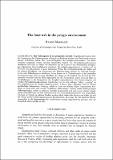Por favor, use este identificador para citar o enlazar a este item:
http://hdl.handle.net/10261/166487COMPARTIR / EXPORTAR:
 SHARE SHARE
 CORE
BASE CORE
BASE
|
|
| Visualizar otros formatos: MARC | Dublin Core | RDF | ORE | MODS | METS | DIDL | DATACITE | |

| Campo DC | Valor | Lengua/Idioma |
|---|---|---|
| dc.contributor.author | Margalef, Ramón | es_ES |
| dc.date.accessioned | 2018-06-18T09:18:55Z | - |
| dc.date.available | 2018-06-18T09:18:55Z | - |
| dc.date.issued | 1967-07 | - |
| dc.identifier.citation | Helgoländer wissenschaftliche Meeresuntersuchungen 15(1-4): 548–559 (1967) | es_ES |
| dc.identifier.issn | 0174-3597 | - |
| dc.identifier.uri | http://hdl.handle.net/10261/166487 | - |
| dc.description | 12 pages | es_ES |
| dc.description.abstract | [EN] 1. The study of grazing along ecological successions helps in understanding how the mechanisms of transfer of energy evolve and provides a measure of its effectiveness in the different situations. Phytoplankton populations show regular changes along succession. Average size of cells and relative abundance of mobile organisms increase, and productivity or rate of multiplication slows down; there are also changes in the chemical composition, exemplified in the plant pigments by an absolute and relative decrease of chlorophyll a. 2. Along a succession, animals are offered different kinds of food, and the resulting selection produces a shift in the composition of zooplankton populations. The speed at which phytoplankton succession proceeds is a very important factor, and grazing may be effective in the regulation of such speed. In a general way, along usual successions, food in the form of small particles, richly suspended in a more or less turbulent environment, is replaced by scarcer food concentrated in bigger units and dispersed in a more organized (stratified) environment. [...] | es_ES |
| dc.description.abstract | [DE] Vergleichende Studien über die Organisation des Nahrungsnetzes während verschiedener Stadien von Planktonsukzessionen können Aufschlüsse liefern über Gesetzmäßigkeiten der Energietransformation. Von dieser Annahme ausgehend, werden zunächst verschiedene Stadien von Phytoplanktonsukzessionen beschrieben und dann an Hand von Beispielen aus der Literatur und theoretischen Erwägungen allgemeinere Gesetzmäßigkeiten abgeleitet. Phytoplanktonpopulationen verändern sich im Verlaufe von Sukzessionen in ganz bestimmter Weise: Die Durchschnittgröße der Zellen und die relative Häufigkeit von Organismen mit Eigenbewegung nehmen zu, während Produktivität oder Zellteilungsrate abnehmen; ferner kommt es zu Veränderungen in der chemischen Zusammensetzung, etwa zu einer Abnahme der Menge an Chlorophyll. Im Verlauf der Sukzessionen verändert sich das Nahrungsangebot für die Zooplankter; dieser Umstand führt zu Verschiebungen in der Komposition der Zooplanktonpopulationen. Die Geschwindigkeit, mit welcher Phytoplanktonsukzessionen fortschreiten, ist ein sehr wichtiger Faktor; „grazing“ ist hier möglicherweise als Geschwindigkeitsregulativ wirksam. [...] | es_ES |
| dc.language.iso | eng | es_ES |
| dc.rights | openAccess | es_ES |
| dc.title | The food web in the pelagic environment | es_ES |
| dc.title.alternative | Das Nahrungsnetz in der pelagischen Umwelt | es_ES |
| dc.type | artículo | es_ES |
| dc.identifier.doi | 10.1007/BF01618650 | - |
| dc.description.peerreviewed | Peer reviewed | es_ES |
| dc.relation.publisherversion | https://doi.org/10.1007/BF01618650 | es_ES |
| dc.relation.csic | Sí | es_ES |
| oprm.item.hasRevision | no ko 0 false | * |
| dc.type.coar | http://purl.org/coar/resource_type/c_6501 | es_ES |
| item.cerifentitytype | Publications | - |
| item.openairecristype | http://purl.org/coar/resource_type/c_18cf | - |
| item.grantfulltext | open | - |
| item.openairetype | artículo | - |
| item.fulltext | With Fulltext | - |
| item.languageiso639-1 | en | - |
| Aparece en las colecciones: | (IIP) Artículos | |
Ficheros en este ítem:
| Fichero | Descripción | Tamaño | Formato | |
|---|---|---|---|---|
| Margalef_1967.pdf | 724,29 kB | Adobe PDF |  Visualizar/Abrir |
CORE Recommender
SCOPUSTM
Citations
40
checked on 25-abr-2024
WEB OF SCIENCETM
Citations
38
checked on 28-feb-2024
Page view(s)
239
checked on 06-may-2024
Download(s)
171
checked on 06-may-2024
Google ScholarTM
Check
Altmetric
Altmetric
NOTA: Los ítems de Digital.CSIC están protegidos por copyright, con todos los derechos reservados, a menos que se indique lo contrario.
